Dave Proctor’s cross-Canada record attempt is 75 per cent done
We reached the ultrarunner for a phone interview as he approached Moose Jaw, Sask.
 Photo by:
Aravaipa Running/Jubilee Paige
Photo by:
Aravaipa Running/Jubilee Paige
Since May 15, Canadian ultrarunner Dave Proctor of Okotoks, Alta. has been on a quest: to break Al Howie’s cross-Canada speed record of 72 days, 10 hours, set in 1991. Proctor started in Newfoundland on May 15, and has been on the road for 51 days, mostly following the Trans-Canada Highway and passing by the Terry Fox memorial in Thunder Bay, Ont., on June 23. He is currently running through Saskatchewan, and expects to reach Victoria on July 21.
This is not Proctor’s first attempt at the record; in 2018, running in the other direction, he was beset by a back injury and forced to quit in Manitoba after 32 days on the road.
Proctor is one of Canada’s most accomplished ultrarunners. He set the 48-hour Canadian record at 6 Days in the Dome in 2018 (358.163 km); in addition, he holds Canadian records over 24 hours (257.093 km) and 72 hours (500.077 km). When he’s not running tremendous distances, he works as a massage therapist in Okotoks, Alta.
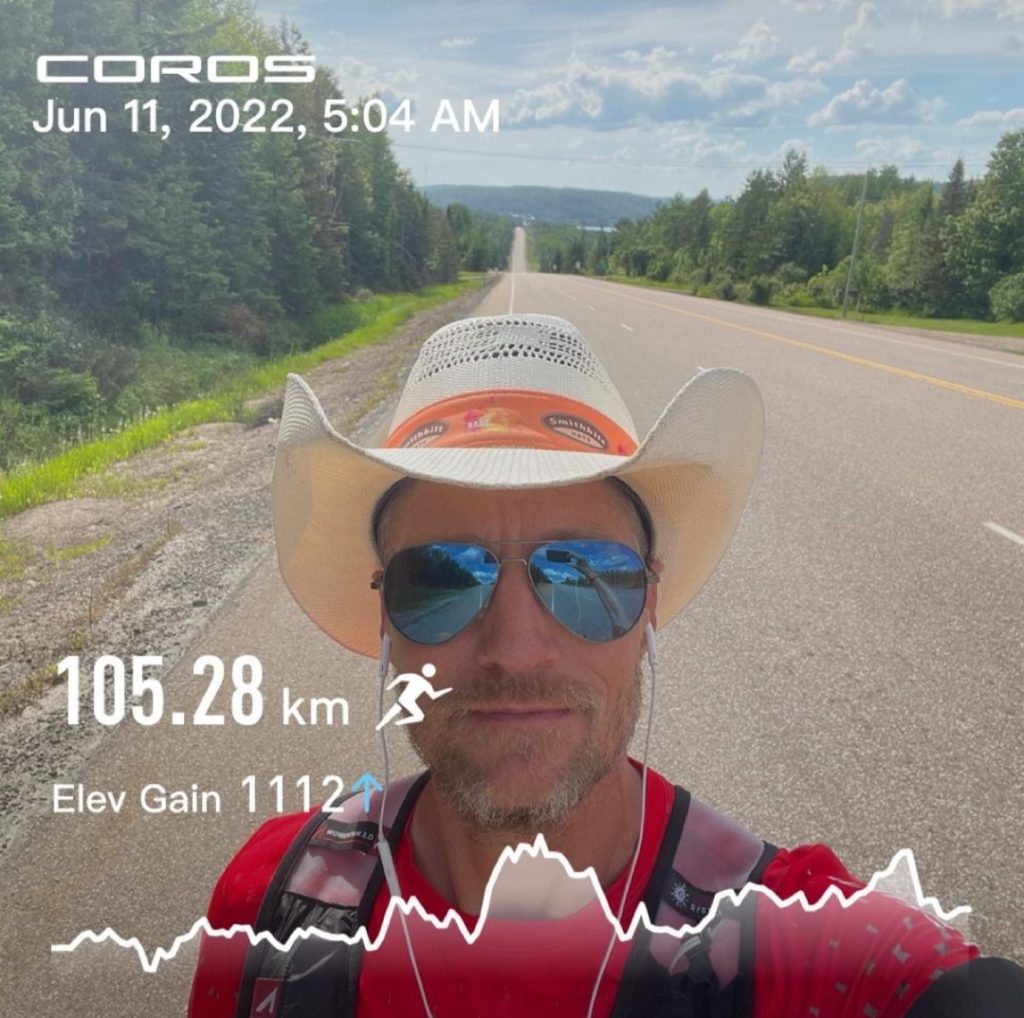
Proctor’s current attempt, originally planned for 2020, was delayed by the pandemic, but finally started on a sunny spring morning with a hat-dip in St. John’s. Proctor has consistently run for about 11 hours a day, covering about 105 km every day. He has not taken a single day off, and his pace has never varied by more than a few seconds per kilometre. (His Strava doesn’t even show his meal breaks; he explained that he has his watch set to auto pause.) A fall resulting in a deep gash to his forehead the day he passed through Thunder Bay (where Terry Fox had to abandon his run in September 1980, when his cancer returned) does not appear to have slowed him down.
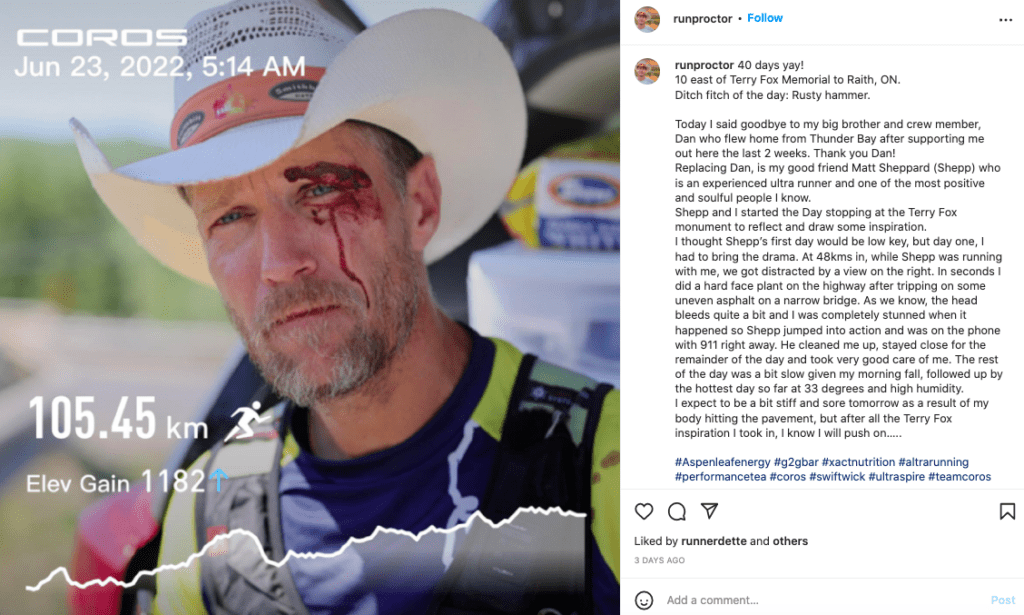
A lot has changed since Proctor’s 2018 attempt; for one thing, he is no longer courting publicity for the effort or fundraising for rare diseases. “For many reasons, I’ve moved away from that, and this time around I’m simply running for myself,” Proctor says. “I want to take this for myself. I have a personal goal of running across the country in record time. I’m putting myself first, and I’m really proud and happy that I’m doing so—in fact, I’ve never run any better, never felt as strong or as capable.”

Proctor adds that fundraising and publicity require a lot of energy and time (as does documenting everything for the Guinness World Records organization), both on his part and his crew’s, and the decision not to do those things this time around was conscious and deliberate. “You can’t do both, I learned in 2018,” he says. “You can’t have a national awareness and fundraising campaign and break the speed record.”
Proctor’s current level of success and consistency present a contrast with the setbacks he has dealt with over the last few years. At Six Days in the Dome, a 6-day race in Wisconsin in 2019, he went out hard, lapping the other competitors and breaking the 48-hour Canadian record, but logged only 313 miles (504 km) over six days, after claiming to be in pursuit of the Canadian 6-day record (which is 541 miles/871 km in the open category and 434 miles/698 km in Proctor’s age category, M40). In 2021, an injury forced him to abandon an FKT attempt across the width of Alberta (a distance of 537 km, which he hoped to cover in 72 hours) after the first day.
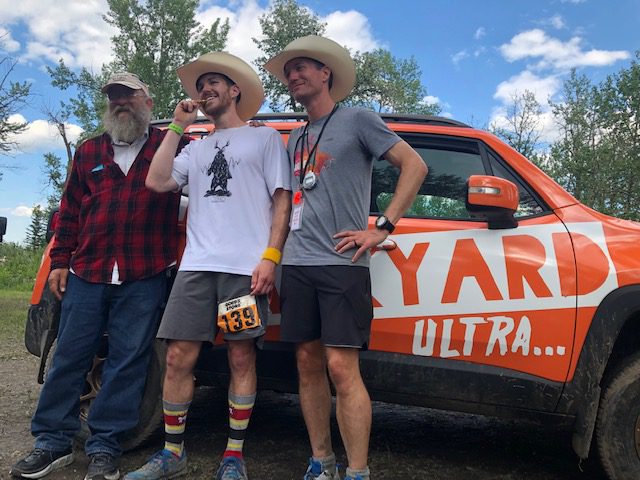
Proctor attributes this to the slower miles he put in in preparation for the current attempt. “I had a more dialled-back approach, into the low Zone 2, doing a lot more longer runs, and definitely a lot slower–which is really difficult to do for the ego. My ego wanted me to go faster, but my 41-year-old mind vs. my 37-year-old mind told me this was a better choice, and it’s been paying dividends. Outside of physical training, I’ve also got a sports psychologist now, and I’ve been on the phone with her every week as I run across the country. Every runner will tell you that running is largely mental, and I think it’s very true … There is not a lot that I can’t work through physically, after running ultras for as long as I have, but the mental component is something we can all work on.”
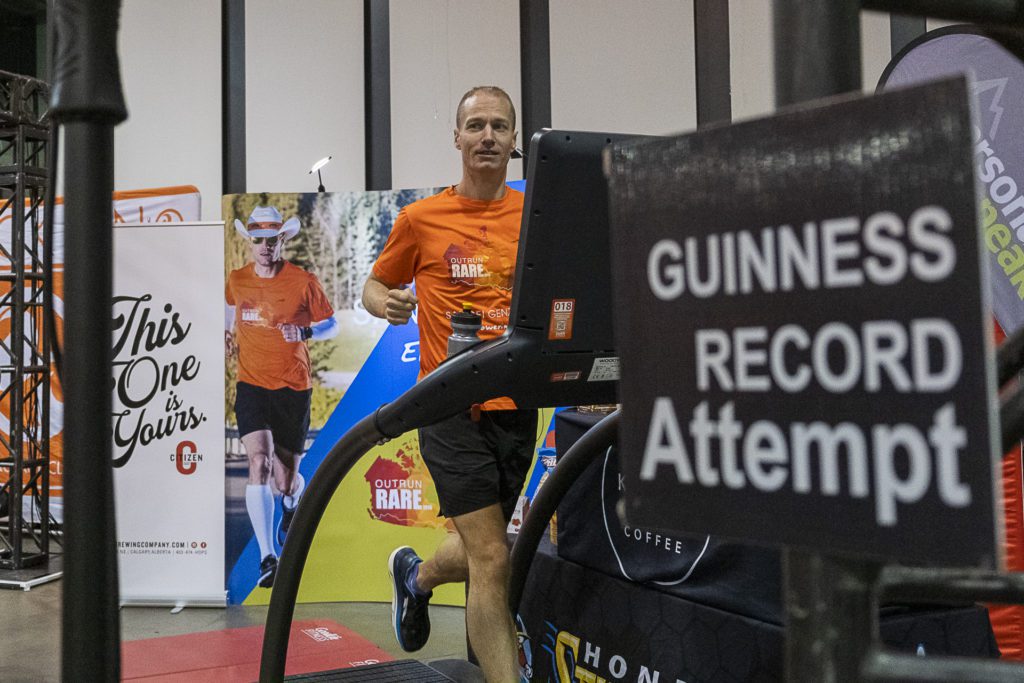
Those interested in “nerding out” on Proctor’s stats may be frustrated by the fact that, until a few weeks ago, the new Strava account he created for this project had his heart rate data toggled off (it is now on). And while “journey runs” of this type are typically documented using sophisticated technology, backed up by witness statements from strangers at regular intervals, Proctor claims ignorance about such matters, leaving it up to his team to document everything.
He was not aware, for example, that his Garmin tracking data shows some gaps between where he stopped and started from day to day (such as on May 16, in Newfoundland, and on June 10, in Deep River, Ont.), despite his practice of marking the spot where he stopped running. His indifference toward the technical documentation of his journey (which he readily admits) is surprising, considering he hopes to claim the title of the fastest person ever to cross Canada on foot. “I’ll share it all at the very end,” he says. “The technical data is all there. If it doesn’t concern me in the moment, I don’t concern myself with it.”
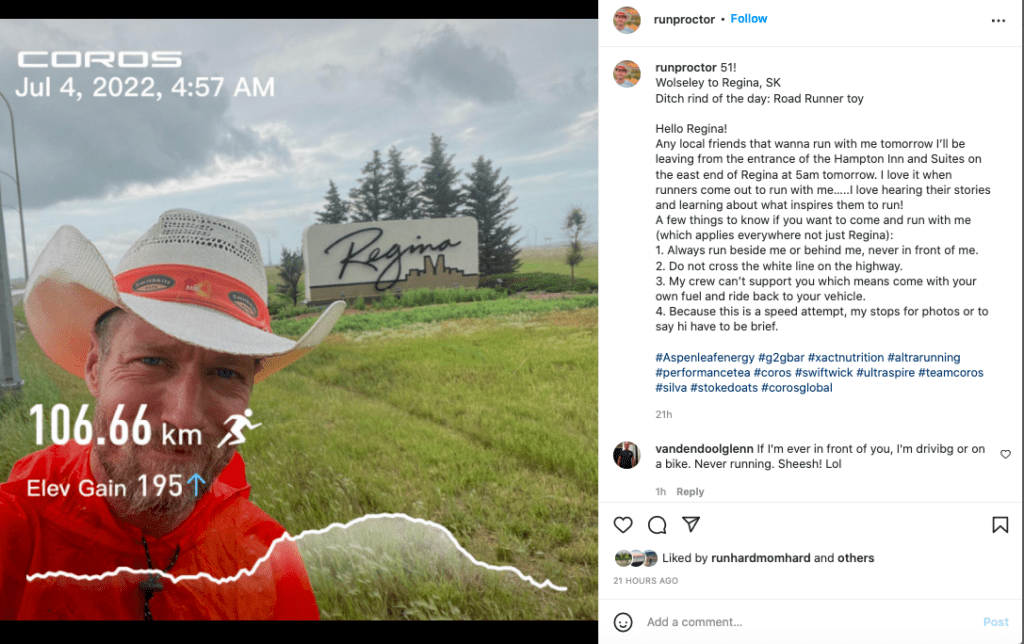
Here are some other questions we asked Proctor when we reached him on Tuesday:
Dave, you’re running on the paved shoulder of a highway most of the time. How are your feet? How are you caring for them?
All the highways in eastern Canada are quite heavily sloped, and quite narrow; my feet took a beating early on, mostly for that reason, but since entering Manitoba and Saskatchewan, the shoulders are wide and not as sloped, and it’s a lot more comfortable. I didn’t get a blister until day 43—I’m wearing the Altra Rivera shoe and Swiftwick socks (I have 12 pairs of shoes, and I’m on pair nine)–but I also have a stride that doesn’t put a lot of strain and stress on my feet … That blister has gone away, and I haven’t had a recurrence.
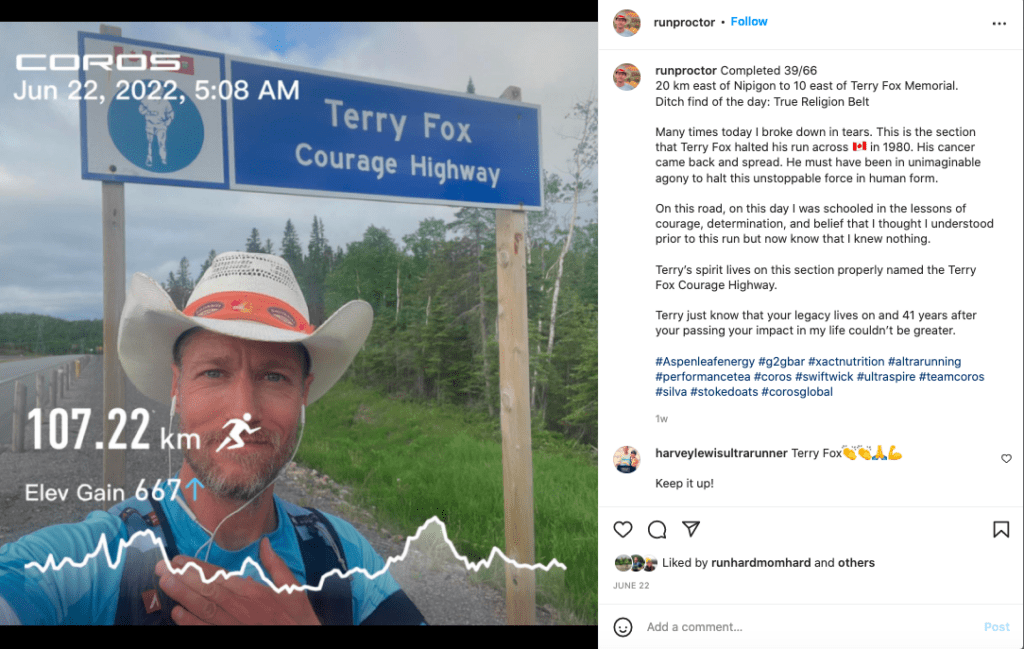
Can you describe your daily routine?
Every day is like Groundhog Day—I’m very systematic and disciplined, and I haven’t fallen off the plan in 51 days. I wake up, and my crew treats me like a toddler–they make my oatmeal and coffee, and I use my Theragun and eat my oatmeal. We leave the hotel and drive to where I stopped the day before. I run 20 km, and they drive ahead and wait for me, and I grab new water bottles and new food to put in my vest, reapply sunscreen, and then do another 20 km. Then we stop again and do the same things. For the rest of the day, it’s sessions of 10 km each. At the end of the day, we mark the side of the highway with Google maps and a pinwheel marker, then drive to the hotel we have booked. Again, my crew treats me like a toddler; they’ve already ordered food, and I have a shower and do body care–I massage my legs and do foot and ankle mobility exercises. I put on my Normatech recovery boots, and I’m falling asleep as I eat my dinner. I got to bed before 8 p.m., and I wake up at 4 a.m.
If you’re following Al Howie’s route, why did you not run through Prince Edward Island?
Al Howie didn’t need to run through PEI, he just did that for fundraising purposes. Ultimately, the run across Canada is a point-to-point run from St. John’s to Victoria. It’s really difficult to know which route he ran, because he didn’t post it; I tried to find maps of where he ran. If I can avoid running downtown in a city, I’m going to run around that city—sometimes it’s longer, sometimes it’s shorter, but it’s always safer.
How did you calculate that you could do the run in 66 days?
I made up my own route using Plotaroute.com. I didn’t even factor in Howie’s 72 days, 10 hours; I started mapping, and said, I know my ultrarunning and what I’m capable of, and I think I can run 105 km every day. That brought it up to 66 days, so that was the number. I’m not very good at the technical side, and I admit I had a couple of beers when I was doing it, because when you’re mapping out the country, you have to numb yourself a little or it scares the living shit out of you. I’ve got people that are redoing the mapping, so it now looks like I’ll be finishing in 67 days, not 66, and I’m averaging 106-107 km a day right now. I think July 21 is the day I arrive in Victoria.


